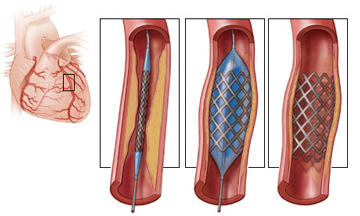What is Interventional Cardiology?
Interventional Cardiology is the branch of cardiology that uses catheter-based techniques for the treatment of structural, functional and electrical heart diseases. This avoids open-heart surgery (the traditional method of repairing structural cardiac defects).
What is Coronary Angioplasty or PCI?
The most common Interventional Cardiology procedure is Coronary Angioplasty or Percutaneous Coronary Intervention (PCI). This is an interventional procedure that uses a balloon-tipped catheter and stent (a small mesh tube), to dilate a coronary artery blockage in patients with coronary artery disease.
Why would you need Coronary Angioplasty (PCI)?
- Elective Coronary Angioplasty (PCI) is indicated in a patient with coronary artery disease who has angina due to a severe stenosis that has been confirmed by a coronary angiogram.
- Emergent or Primary Angioplasty is the treatment of choice for heart attack patients with ST Elevation Myocardial Infarction (STEMI). Patients with chest pain suggestive of a heart attack, should be seen urgently in a Hospital Emergency Department for immediate therapy to reopen the coronary artery if STEMI is confirmed.
How is the Coronary Angioplasty (PCI) procedure performed?
At the start of the procedure, your cardiologist inserts the thin catheter through a small puncture into an artery in your arm or leg and uses X-rays to guide the catheter to the coronary artery blockage. A balloon at the tip of the catheter is inflated within the coronary artery at the site of the blockage, expanding and forcing open the blood vessel, thus leading to improved flow. A catheter then delivers a stent to the blockage. The stent is inflated with the balloon-tipped catheter. The stented coronary artery remains wide open after the balloon is deflated and withdrawn. Stents may be coated with medication (drug-eluting stent), which helps prevent scarring while the artery heals.
What does the coronary artery look like before and after Coronary Angioplasty (PCI) with a stent?
Severe stenosis before stenting
No residual stenosis after stenting
What are some other Interventional Cardiology Procedures?
- Thoracic Endovascular Aortic Repair (TEVAR) to treat an aneurysm, dissection or stenosis of the thoracic aorta.
- Transcatheter Aortic Valve Replacement (TAVR) to replace the aortic valve in patients with severe aortic valve stenosis
- Transcatheter ASD Device Closure for correcting a Congenital Atrial Septal Defect (ASD).
Patients require thorough cardiovascular evaluation to determine whether they are suitable for these minimally invasive novel interventional procedures.



